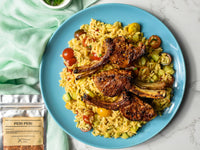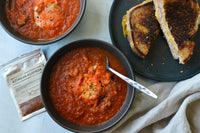Recipes
Lemon Pepper Shrimp

Serves 4
| Prep Time: 10 mins
| Cook Time: 10 mins
| Total Time: 20 mins
Discover The Recipe
Lemon Pepper Shrimp is a finger-licking snack commonly served in roadhouses and street stalls throughout Jamaica. Quick to prepare, the tangy-lemony-garlicky flavor and fruity heat of Jamaica's Scotch Bonnet peppers are sure to delight. The best thing is that this recipe only requires a few ingredients and one pan, so it's a perfect weeknight meal. We recommend cooking shell-on, tail-on shrimp since they steam inside their shell, so you can use less oil.
Scotch Bonnet peppers are similar to habanero peppers on the heat scale, but offer more fruity notes than Habaneros. Jamaicans use these peppers in many of their dishes, including the signature Jerk marinades and seasonings. The Scotch Bonnet pepper flakes we provide as a standalone spice are hotter than the ubiquitous pizzeria red pepper flakes, so it's best to begin with a relatively small amount in a recipe: 1/8 tsp for a lower tolerance to heat to 1/4 tsp or more if you like a little fire in your food. Start low and dial up the heat after you sample the cooked dish.
Ingredients
1-1.5 lb tail-on, shell-on shrimp, deveined and legs removed
2 cloves of garlic, chopped
1 tbsp olive (or canola) oil
1 lemon, juiced (~2 tbsp)
handful of cilantro (or flat leaf parsley), roughly chopped for garnish (optional)
salt and pepper to taste (optional)
Piquant Post Scotch Bonnet Pepper, to taste (optional - these are hot, test a small amount like 1/4 tsp first)
Notes
Be careful when cooking with Scotch Bonnet pepper flakes. Make sure to cook with Med or Med-Low heat on your pan as you don't want to overcook the shrimp or vaporize the natural oils in the Scotch Bonnet peppers. Do not cook pepper flakes if your oil is smoking, as the airborne oils of chili peppers can irritate your eyes and throat. Be safe and start with lower heat than typical frying or sautéing.
We serve these shrimp in a bowl as "peel and eat shrimp" to get maximum benefit of flavor. Suck the flavor from the whole shrimp then peel and eat!
Can you use shell-off shrimp? Of course! But shell-off shrimp tend to stick to the pan so you might need to use more oil than our recipe recommends.
If using fresh whole shrimp, here's a refresher video on how to devein and declaw shrimp. Pull the legs, snip the top of the shell down the spine (leaving shell on if desired), and use a knife to devein.
Lastly, optional ingredients add a little character and flavor but don’t sweat it if you don’t have them.
Instructions
Preheat a skillet or pan on Med and add oil. Prep garlic and juice lemon then set aside. When pan is hot, add shrimp and cook for 3 mins then flip.
Alternatives & Substitutions
Lemon Pepper Shrimp is a classic recipe to have in your collection, mainly because lemon pepper is a classic flavor collection. If you don't (or can't) eat shellfish, you can sub just about anything into the pan from chicken to tofu to a veggie medley (zucchini, squash, asparagus, eggplant, etc).
If one of your dinner guests is sensitive to spicy heat, cook their portion first with regular ground black pepper without using the Scotch Bonnet flakes. Then cook your spicy lemon pepper shrimp 🙂
Post pictures of your masterpiece meal on social media and tag us. We repost!
Lemon Pepper Shrimp
Ingredients
1-1.5 lb tail-on, shell-on shrimp, deveined and legs removed
2 cloves of garlic, chopped
1 tbsp olive (or canola) oil
1 lemon, juiced (~2 tbsp)
handful of cilantro (or flat leaf parsley), roughly chopped for garnish (optional)
salt and pepper to taste (optional)
Piquant Post Scotch Bonnet Pepper, to taste (optional - these are hot, test a small amount like 1/4 tsp first)
Instructions
Preheat a skillet or pan on Med and add oil. Prep garlic and juice lemon then set aside. When pan is hot, add shrimp and cook for 3 mins then flip.
Notes
Be careful when cooking with Scotch Bonnet pepper flakes. Make sure to cook with Med or Med-Low heat on your pan as you don't want to overcook the shrimp or vaporize the natural oils in the Scotch Bonnet peppers. Do not cook pepper flakes if your oil is smoking, as the airborne oils of chili peppers can irritate your eyes and throat. Be safe and start with lower heat than typical frying or sautéing.
We serve these shrimp in a bowl as "peel and eat shrimp" to get maximum benefit of flavor. Suck the flavor from the whole shrimp then peel and eat!
Can you use shell-off shrimp? Of course! But shell-off shrimp tend to stick to the pan so you might need to use more oil than our recipe recommends.
If using fresh whole shrimp, here's a refresher video on how to devein and declaw shrimp. Pull the legs, snip the top of the shell down the spine (leaving shell on if desired), and use a knife to devein.
Lastly, optional ingredients add a little character and flavor but don’t sweat it if you don’t have them.




